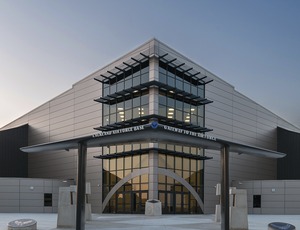General contractor ECC encountered several safety and logistics challenges during construction of the $21.7-million, 70,299-sq-ft U.S. Air Force Recruit Family In-Processing and Information Center.

The roof height in RFIIC's open central lobby and auditorium slopes upward from 28 ft in the front of the auditorium to 55 ft at the lobby peak. As a result, all mechanical, electrical and ceiling installation had to be performed at high elevations. The building foundation is a cast-in-place concrete, pan-joist system supported on concrete piers, which limited lift weights to a maximum concentrated wheel load of 2,500 lb, with a minimum spacing of 4 ft in each direction. However, lift use was critical to access the heights under an aggressive schedule.
To handle this, project engineers and the safety team created a gridded floor plan to ensure that no two lifts would be placed within the area of four adjacent concrete piers. The plan was placed in each lift so crews would know how close they could work to an adjacent lift.
Crews executed numerous activities simultaneously, requiring orchestrated teamwork. ECC developed a comprehensive work-flow strategy and led daily meetings to coordinate tasks and locations, avoid conflicts, do work in phases and maximize efficiency. Subcontractors also shared lifts, further increasing efficiency.
ECC subcontractor JSR fabricated an entrance arbor by retrofitting two salvaged DC-9 tail wings to replicate an aircraft's wing span. The newly fabricated wing formed a 35-ft wing span and was mounted on two 11-ft steel columns designed to resemble structural airfoils.
ECC custom-built the truss on site throughout 56,000 sq ft of roof space based on engineered drawings. Two crews worked side by side to concurrently build, set and inspect 15-ft to 25-ft trusses across the expansive area. Onsite construction eliminated the typical procurement period for a prefabricated truss, and since each truss was erected upon completion, subsequent tasks could start earlier.
During 201,244 total man-hours, the team had no lost-time accidents and just one OSHA recordable incident. The safety judges were impressed with the contractor's implementation of OSHA Voluntary Protection Program principles on this project and achievement of OSHA VPP Star Status in the Mobile Workforce Program for the San Antonio Designated Geographic Area in 2010.
The RFIIC was ECC's key effort in the VPP program for 2012 and 2013. The project served as a VPP model for construction safety, with OSHA holding its quarterly VPP regional meeting on site. The project's site-specific safety program included in-depth safety orientations, activity hazard-analysis discussions, morning and afternoon Plan of the Day meetings six days a week, emergency action drills, AHA training and daily toolbox meetings.
Early in the project, the contractor established a rigorous construction quality control program and a three-phase inspection approach to ensure schedule and quality performance with all disciplines. Some of the sustainable construction practices included use of regional and recycled materials to reduce landfill waste and pollutants. The Air Force benefits from RFIIC's sustainability through elevated building performance and reduced operations and maintenance costs.
Key Players
General Contractor ECC, San Antonio
Owner AFCEC, San Antonio
Lead Design Rehler, Vaughn and Koone (RVK) Architects, San Antonio
Structural Campbell & Associates, Dallas
Civil Matkin Hoover Engineering, Boerne, Texas
MEP Barker & Associates, San Antonio






Post a comment to this article
Report Abusive Comment